Characterization of Contact Pressure Distribution and Bruising Prediction of Apple under Compression Loading
Abstract
1. Introduction
2. Materials and Methods
2.1. Samples
2.2. Compression Tests and PSF Measurements
2.3. Apple Bruise Measurements
2.4. Finite Element Analysis
2.4.1. Model and Mesh Generation
2.4.2. Simulation Analysis
3. Results and Discussion
3.1. Changes in Bruise and PSF Contact Pressure Distribution
3.2. The PSF Pressure Distribution Characteristics and Their Relationship with Bruising
3.3. Prediction of Bruise Area with FE Simulation of Contact Stress
4. Conclusions
Author Contributions
Funding
Data Availability Statement
Conflicts of Interest
References
- Herold, B.; Geyer, M.; Studman, C. Fruit contact pressure distributions—Equipment. Comput. Electron. Agric. 2001, 32, 167–179. [Google Scholar] [CrossRef]
- Amiri, A.; Bompeix, G. Micro-wound detection on apple and pear fruit surfaces using sulfur dioxide. Postharvest Biol. Technol. 2005, 36, 51–59. [Google Scholar] [CrossRef]
- Acican, T.; Alibis, K.; Ozelkok, I.S. Mechanical damage to apple during transport in wooden grates. Biosyst. Eng. 2007, 96, 239–248. [Google Scholar] [CrossRef]
- Lewis, R.; Yoxall, A.; Canty, L.A.; Reina Romo, E. Development of engineering design tools to help reduce apple bruising. J. Food Eng. 2007, 83, 356–365. [Google Scholar] [CrossRef]
- Ahmadi, E.; Ghassemzadeh, H.R.; Sadeghi, M.; Moghaddam, M. The effect of impact and fruit properties on the bruising of peach. J. Food Eng. 2010, 97, 110–117. [Google Scholar] [CrossRef]
- Chakespari, A.G.; Rajabipour, A.; Mobli, H. Strength behavior study of apples (cv. Shafi Abadi & Golab Kohanz) under compression loading. Mod. Appl. Sci. 2010, 4, 173–182. [Google Scholar] [CrossRef][Green Version]
- Van Zeebroeck, M.; Van Linden, V.; Darius, P.; De Ketelaere, B.; Ramon, H.; Tijskens, E. The effect of fruit factors on the bruise susceptibility of apples. Postharvest Biol. Technol. 2007, 46, 10–19. [Google Scholar] [CrossRef]
- Van Zeebroeck, M.; Van Linden, V.; Ramon, H.; De Baerdemaeker, J.; Nicolai, B.M.; Tijskens, E. Impact damage of apples during transport and handling (Review). Postharvest Biol. Technol. 2007, 45, 157–167. [Google Scholar] [CrossRef]
- Pang, W.L.; Studman, C.J.; Ward, G.T. Bruising damage in apple-to-apple impact. J. Agric. Eng. Res. 1992, 52, 229–240. [Google Scholar] [CrossRef]
- Pang, W.L.; Studman, C.J.; Banks, N.H. Analysis of damage thresholds in apple-to-apple impacts using an instrumented sphere. N. Z. J. Crop Hortic. Sci. 1992, 20, 159–166. [Google Scholar] [CrossRef]
- Studman, C.J. Model of fruit bruising. In Proceedings of the 2nd Australasian Postharvest Conference, Science and Technology for the Fresh Food Revolution; Institute for Horticultural Development, Department of Natural Resources and the Environment: Canberra, Australia, 1996; pp. 241–246. [Google Scholar]
- Studman, C.J. Handling Systems and Packaging. In CIGR Agricultural Engineering Handbook; Bakker-Arkema, F.W., Ed.; American Society of Agricultural Engineers: St. Joseph, MI, USA, 1999; Chapter 3; Volume IV.3, pp. 291–340. [Google Scholar]
- Schoorl, D.; Holt, J.E. Bruise resistance measurements in apples. J. Texture Stud. 1980, 11, 389–394. [Google Scholar] [CrossRef]
- Johnson, K.L. Contact Mechanics; Cambridge University Press: New York, NY, USA, 1985. [Google Scholar]
- Geyer, M.; Herold, B.; Studman, C.J. Fruit contact pressure distributions. In Proceedings of the Conference Proceedings, Ag Eng 98, Oslo, Norway, 24–27 August 1998. 98-F-001. [Google Scholar]
- Herold, B.; Truppel, I.; Siering, G.; Geyer, M. A pressure measuring sphere for monitoring handling of fruit and vegetables. Comput. Electron. Agric. 1996, 15, 73–88. [Google Scholar] [CrossRef]
- Kohyama, K.; Sasaki, T.; Dan, H. Active stress during compression testing of various foods measured using a multiple-point sheet sensor. Biosci Biotechnol Biochem. 2003, 67, 1492–1498. [Google Scholar] [CrossRef] [PubMed]
- Van Zeebroeck, M.; Dintwa, E.; Tijskens, E.; Deli, V.; Loodts, J.; De Baerdemaeker, J.; Ramon, H. Determining tangential contact force model parameters for viscoelastic materials (apples) using a rheometer. Postharvest Biol. Technol. 2004, 33, 111–125. [Google Scholar] [CrossRef]
- Li, Y.C.; Song, S.J.; Zhao, C.X. Dropping impact experiment of crisp pears and contact pressure analysis. Int. J. Food Prop. 2023, 26, 2826–2837. [Google Scholar] [CrossRef]
- Timoshenko, S.P.; Goodier, J.N. Theory of Elasticity, 3rd ed.; McGraw-Hill: New York, NY, USA, 1970. [Google Scholar]
- Siyami, S.; Brown, G.K.; Burgess, G.J.; Gerrish, J.B.; Tennes, B.R.; Burton, C.L.; Zapp, R.H. Apple impact bruise prediction models. Trans. Am. Soc. Agric. Eng. 1988, 31, 1038–1046. [Google Scholar] [CrossRef]
- Khan, A.A.; Vincent, J.F. Anisotrophy of apple parenchyma. J. Sci. Agric. 1990, 52, 455–466. [Google Scholar] [CrossRef]
- Khan, A.A.; Vincent, J.F. Anisotrophy in the fracture properties of apple flesh as investigated by crack opening tests. J. Mater. Sci. 1993, 28, 45–51. [Google Scholar] [CrossRef]
- Studman, C. Factors affecting the bruise susceptibility of fruit. In Proceedings of the Conference on Plant Biomechanics, Reading, UK, 7–12 September 1997; Jeronimidis, G., Vincent, J.F.V., Eds.; University of Reading: Reading, UK, 1997; pp. 273–281. [Google Scholar]
- Mohsenin, N.N. Physical Properties of Plant and Animal Materials; Gordon and Breach: New York, NY, USA, 1970; Volume 1, pp. 88–100, 341–365, 401–430. [Google Scholar]
- Rabelo, G.F.; Fabbro, I.M.; Linares, A.W. Contact stress area measurement of spherical fruit. In Proceedings of the III International Symposium on Sensors in Horticulture, Haifa, Israel, 17–21 August 1997; pp. 195–200. [Google Scholar]
- Dan, H.; Okuhara, K.; Kohyama, K. Visualization of planar stress distributions in cucumber cultivars using a multiple-point sheet sensor. J. Sci. Food Agric. 2004, 84, 1091–1096. [Google Scholar] [CrossRef]
- Dan, H.; Okuhara, K.; Kohyama, K. Mechanical stress distributions in cross-sections of cucumber cultivars during the fracture process. J. Sci. Food Agric. 2006, 86, 26–34. [Google Scholar] [CrossRef]
- Dan, H.; Azuma, T.; Kohyama, K. Characterization of spatiotemporal stress distribution during food fracture by image texture analysis methods. J. Food Eng. 2007, 81, 429–436. [Google Scholar] [CrossRef]
- Wang, A.Y.; Lu, S.B.; Ma, Z.P.; Bi, S. Development and biomechanics application of a pressure sensitive film imaging and analysis system. Beijing Biomed. Eng. 2001, 20, 282–284. [Google Scholar]
- Liau, J.J.; Hu, C.C.; Cheng, C.K.; Huang, C.H.; Lo, W.H. The influence of inserting a Fuji pressure sensitive film between the tibiofemoral joint of knee prosthesis on actual contact characteristics. Clin. Biomech. 2001, 16, 160–166. [Google Scholar] [CrossRef] [PubMed]
- Liau, J.J.; Cheng, C.K.; Huang, C.H.; Lo, W.H. Effect of Fuji pressure sensitive on actual contact characteristics of artificial tibiofemoral joint. Clin. Biomech. 2002, 17, 698–704. [Google Scholar] [CrossRef]
- Maklewska, E.; Krucinska, I.; Mayers, G.E. Estimating the shock-absorbing ability of protector materials by use of pressure films. Fibres Text. East. Eur. 2005, 13, 52–55. [Google Scholar]
- Maklewska, E.; Krucinska, I.; Mayers, G.E.; Ebner, B. Two stage test verifies shock absorption ability of materials used in protective clothing. Res. J. Text. Appar. Res. Technol. Manag. 2006, 5, 1–7. [Google Scholar]
- Bachus, K.N.; Demarcoa, A.L.; Judd, K.T. Measuring contact area, force, and pressure for bioengineering applications: Using Fuji film and TekScan systems. Med. Eng. Phys. 2006, 28, 483–488. [Google Scholar] [CrossRef]
- Zach, L.; Horak, L.; Ruzicka, P.; Konvickova, S. Knee joint edoprosthesis—Verification of contact pressures by pressure sensitive films. Proc. World Congr. Eng. 2008, 2, 2–4. [Google Scholar]
- Lu, F.; Ishikawa, Y.; Kitazawa, H.; Satake, T. Measurement of impact pressure and bruising of apple fruit using pressure-sensitive film technique. J. Food Eng. 2010, 96, 614–620. [Google Scholar] [CrossRef]
- Lu, F.; Ishikawa, Y.; Kitazawa, H.; Satake, T. Impact damage to apple fruits in commercial corrugated fiberboard box packaging evaluated by the pressure-sensitive film technique. J. Food Agric. Environ. 2010, 8, 132–136. [Google Scholar]
- Wu, J.; Guo, K.Q.; Ge, Y.; Wang, Y.Y. Contact pressure distribution characteristics of Korla pear fruit at moment of drop impact. Trans. CSAE 2012, 28, 250–254. [Google Scholar] [CrossRef]
- Wu, J.; Li, F.; Ge, Y.; Hu, R. Measurement of contact pressure of Korla pear under compression and bruising predication using finite element analysis. Trans. CSAE 2013, 29, 261–266. [Google Scholar]
- Sun, H.J.; Wu, J.; Feng, Z.; Wang, Z.P. Contact stress of drop impact to corrugated board and damage predication for Korla pear. Mod. Food Sci. Technol. 2014, 30, 48–52. [Google Scholar] [CrossRef]
- Stopa, R.; Szyjewicz, D.; Komarnicki, P.; Kuta, Ł. Determining the resistance to mechanical damage of apples under impact loads. Postharvest Biol. Technol. 2018, 146, 79–89. [Google Scholar] [CrossRef]
- Kim, G.W.; Kim, M.S.; Sagara, Y.; Bae, Y.H.; Lee, I.B.; Do, G.S.; Lee, S.H.; Kang, S.W. Determination of the viscoelastic properties of apple flesh under quasi-static compression based on finite element method optimization. Food Sci. Technol. Res. 2008, 14, 221–231. [Google Scholar] [CrossRef]
- Dintwa, E.; Van Zeebroeck, M.; Ramon, H.; Tijskens, E. Finite element analysis of the dynamic collision of apple fruit. Postharvest Biol. Technol. 2008, 49, 260–276. [Google Scholar] [CrossRef]
- Sadrnia, H.; Rajabipour, A.; Jafari, A.; Javadi, A.; Mostofi, Y.; Kafashan, J.; Dintwa, E.; De Baerdemaeker, J. Internal bruising prediction in watermelon compression using nonlinear models. J. Food Eng. 2008, 86, 272–280. [Google Scholar] [CrossRef]
- Stopa, R.; Komarnicki, P.; Kuta, Ł.; Szyjewicz, D.; Słupska, M. Modeling with the finite element method the influence of shaped elements of loading components on the surface pressure distribution of carrot roots. Comput. Electron. Agric. 2019, 167, 105046. [Google Scholar] [CrossRef]
- Liu, X.P.; Cao, Z.T.; Yang, L.; Chen, H.; Zhang, Y.L. Research on Damage Properties of Apples Based on Static Compression Combined with the Finite Element Method. Foods 2022, 11, 1851. [Google Scholar] [CrossRef] [PubMed]
- Wu, M.; Chen, J.S.; Huang, W.J.; Yan, B.; Peng, Q.Y.; Liu, J.F.; Chen, L.Y.; Zeng, H.B. Injectable and self-healing nanocomposite hydrogels with ultrasensitive pH-responsiveness and tunable mechanical properties: Implications for controlled drug delivery. Biomacromolecules 2020, 21, 2409–2420. [Google Scholar] [CrossRef] [PubMed]
- Kim, G.W.; Do, G.S.; Bae, Y.; Sagara, Y. Analysis of mechanical properties of whole apple using finite element method based on three-dimensional real geometry. Food Sci. Technol. Res. 2008, 14, 329–336. [Google Scholar] [CrossRef]
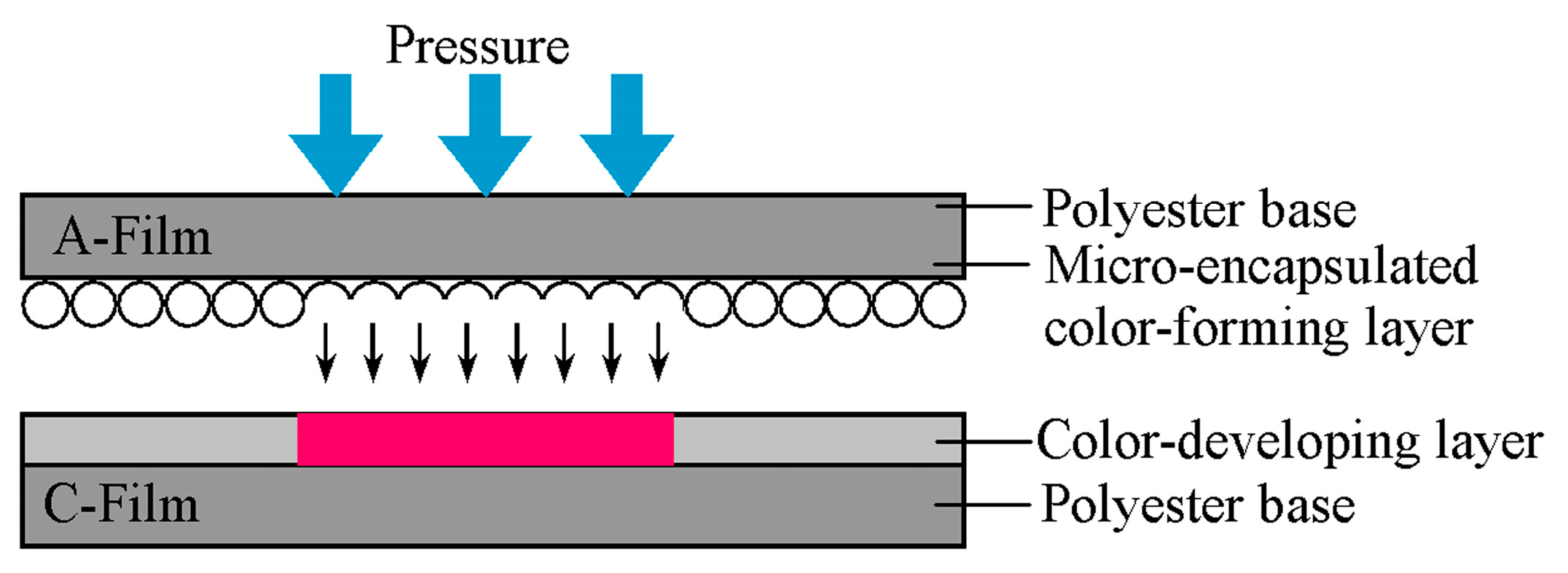




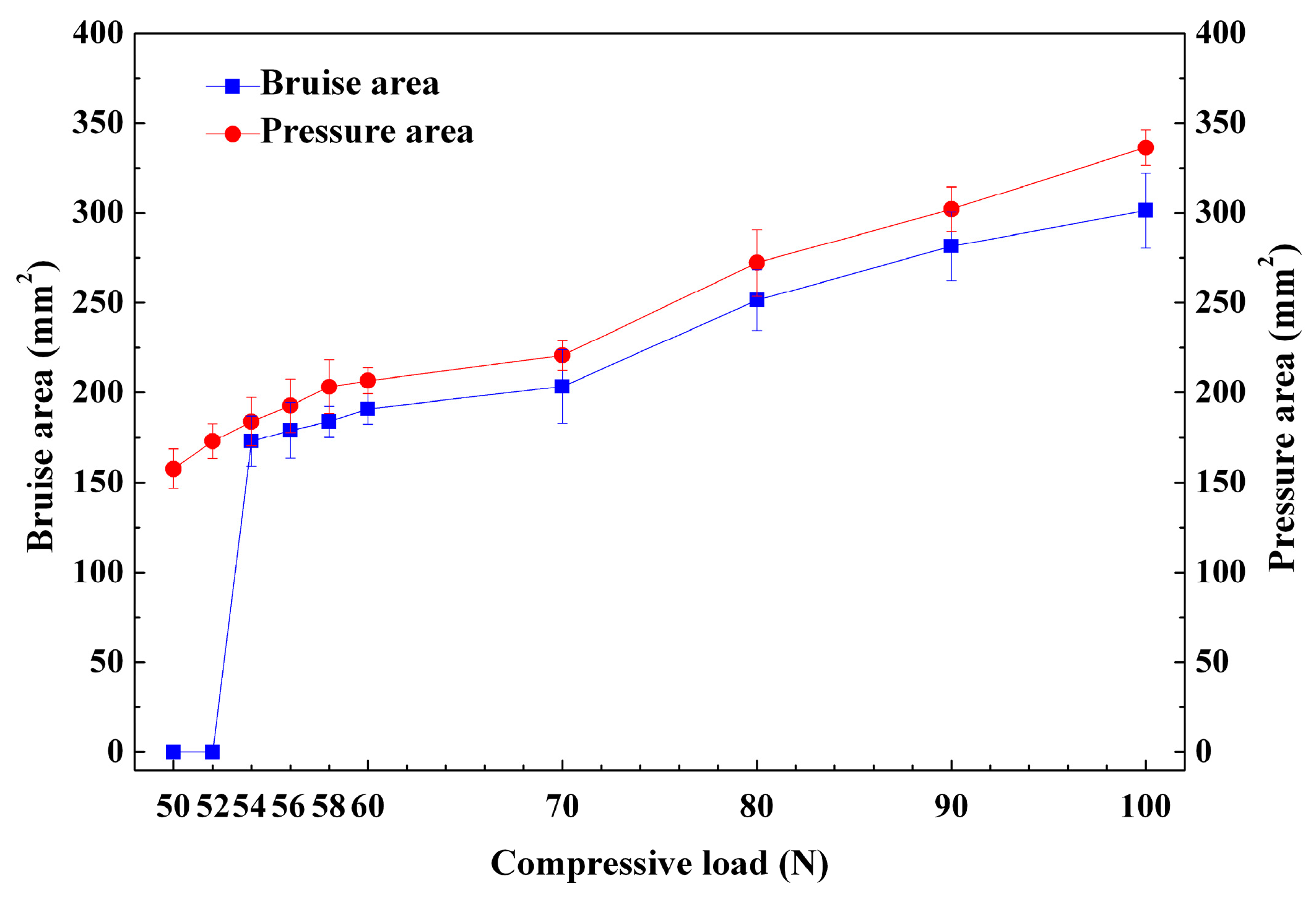

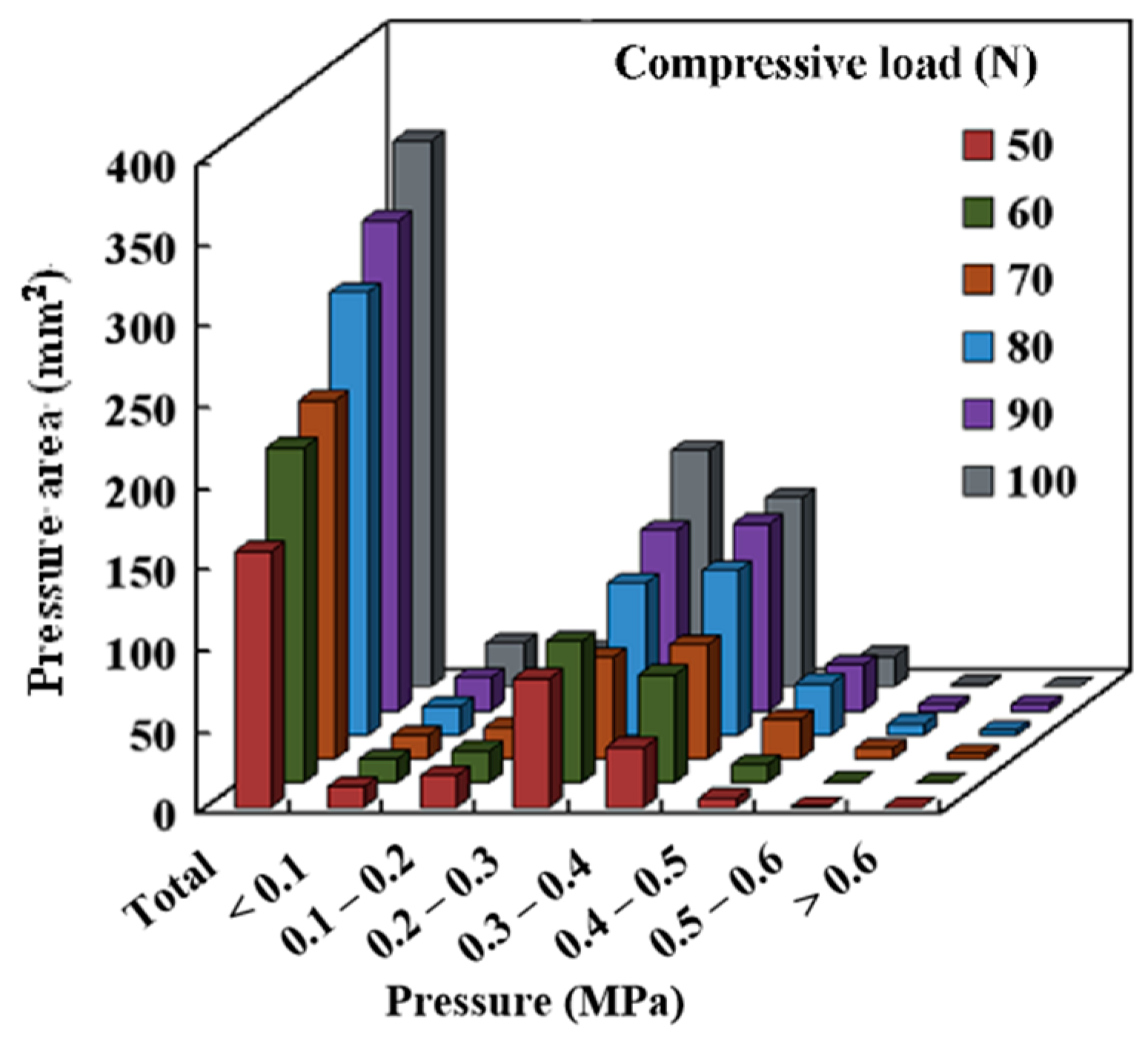
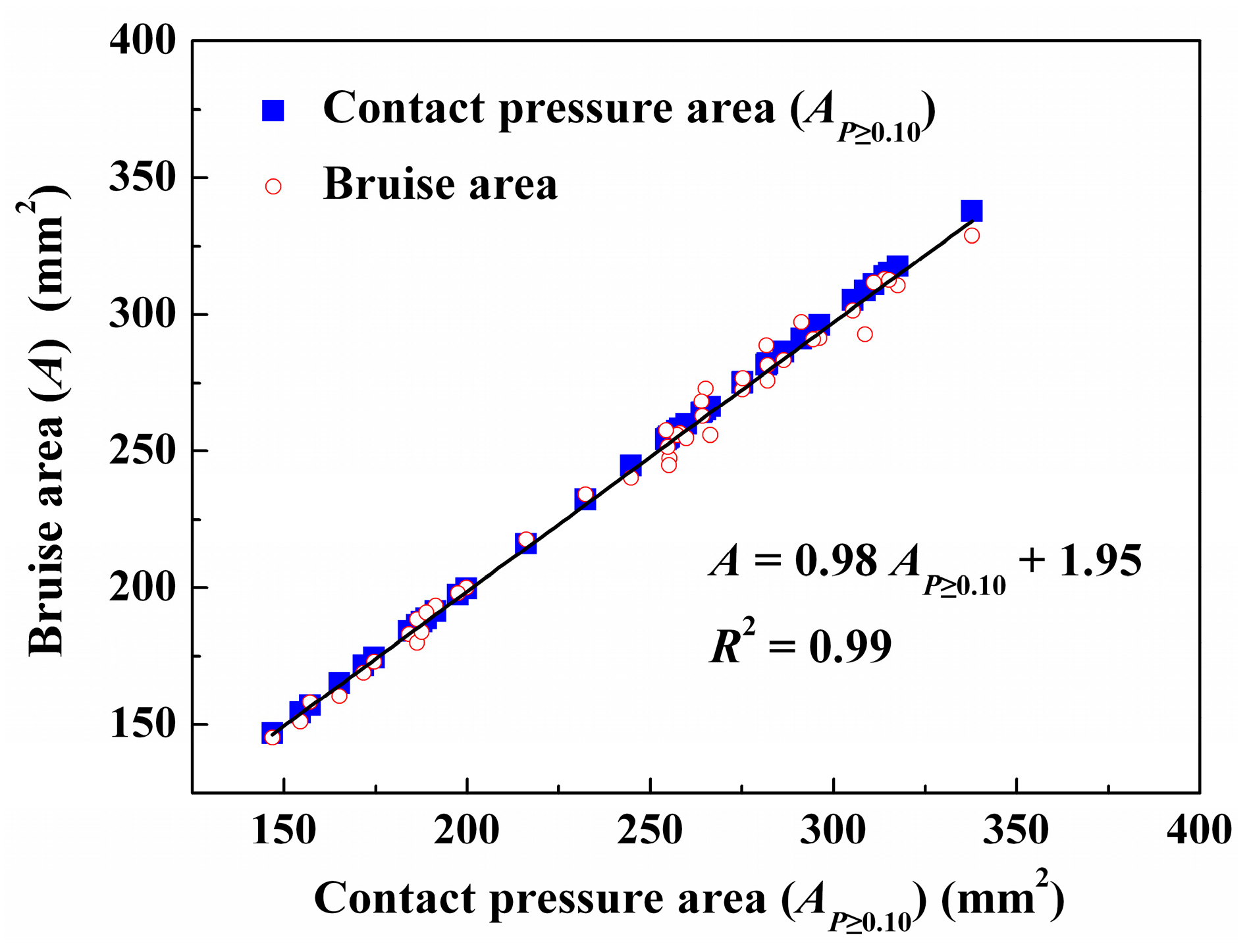
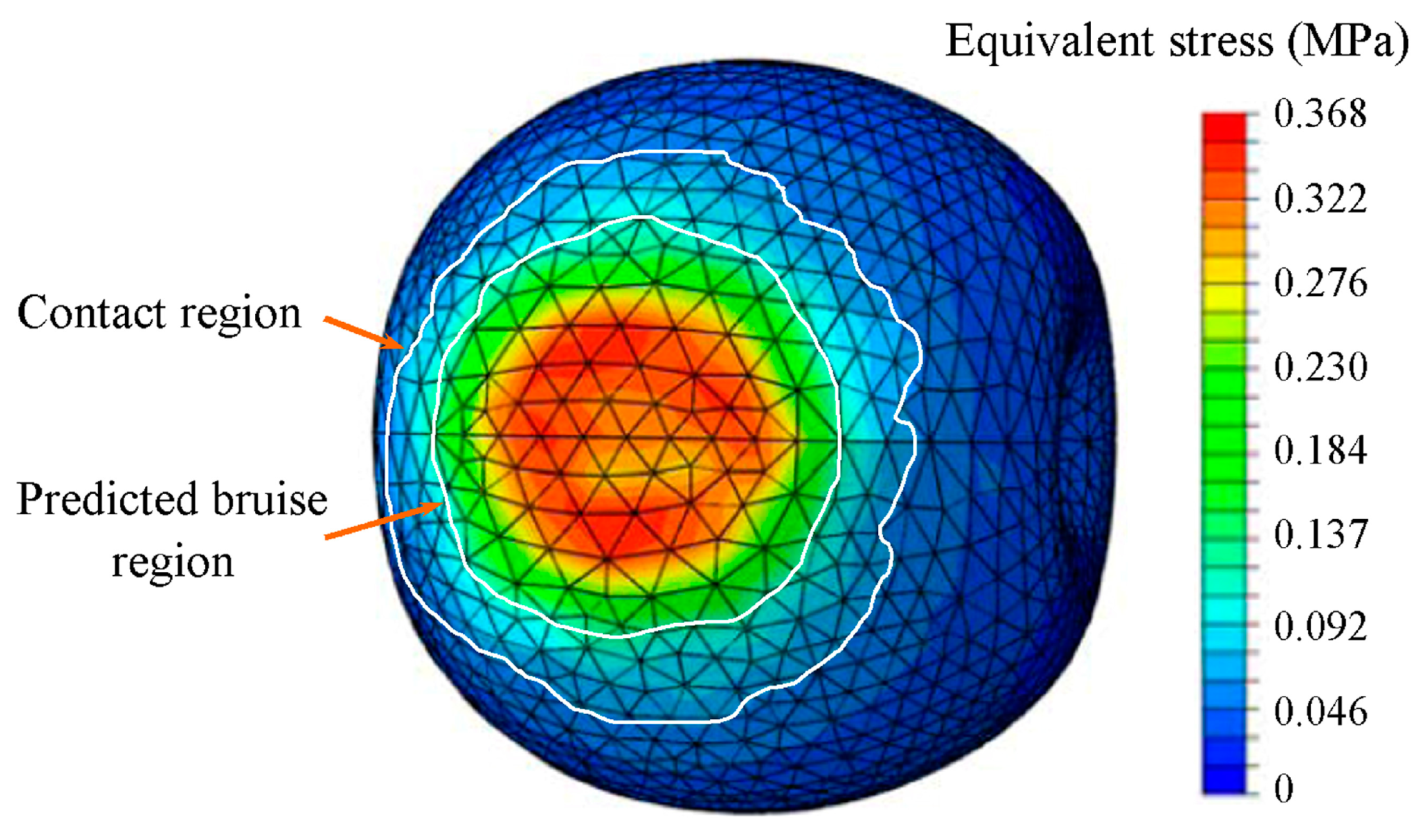

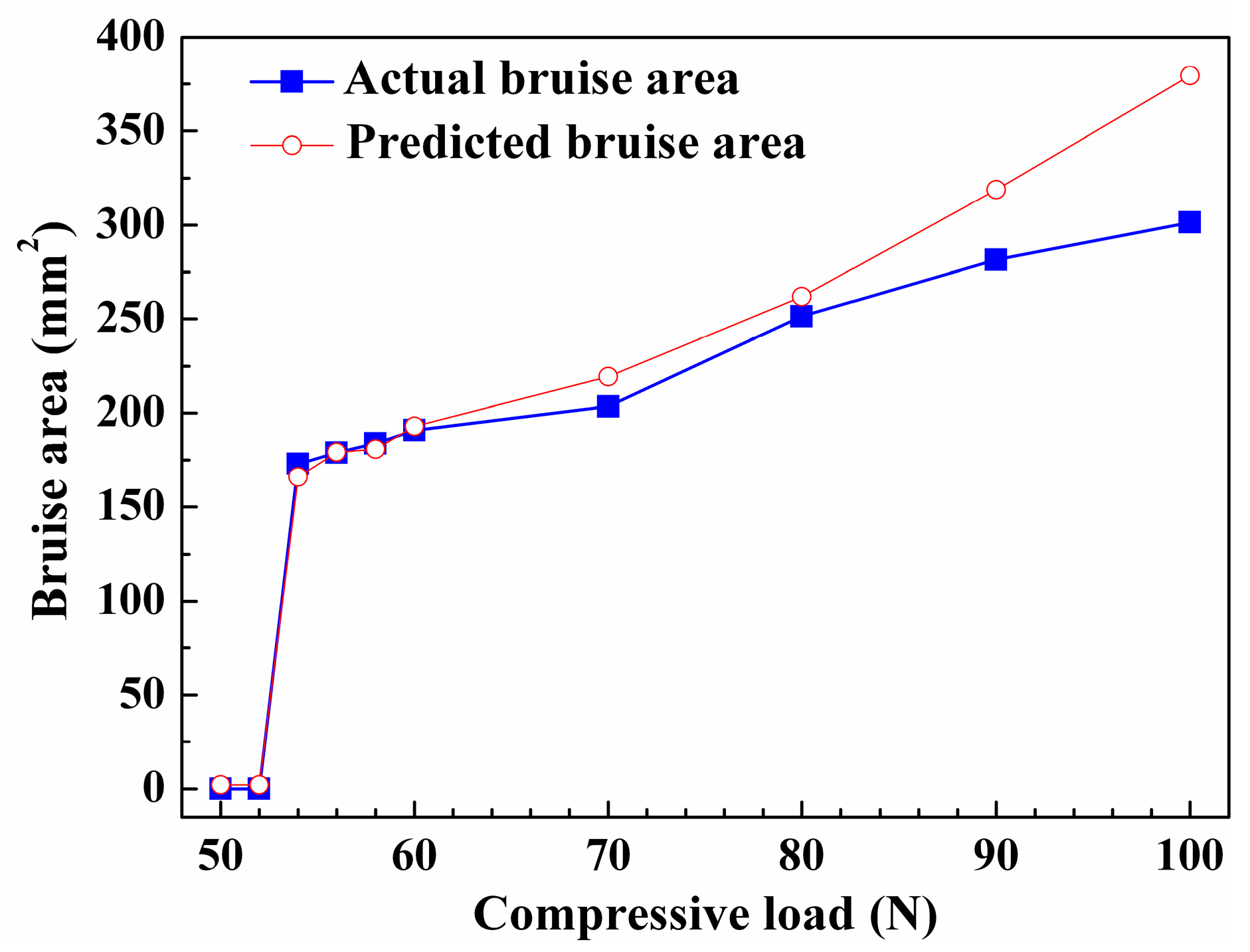
| Value | |
|---|---|
| Mass (g) | 200.0 ± 6.7 |
| Firmness (N) | 79.9 ± 2.6 |
| Soluble solid content (°Brix) | 13.7 ± 0.4 |
| Water content (%) | 86.8 ± 1.2 |
| Material Properties | Values | |
|---|---|---|
| Apple | Plate | |
| Elastic modulus (MPa) | 2.36 | 2 × 105 |
| Poisson’s ratio | 0.34 | 0.30 |
| Density (Kg/m3) | 1000 | 7800 |
| Compressive Load (N) | Average Difference by the PSF (%) | ||||
|---|---|---|---|---|---|
| ≥0 MPa | ≥0.05 MPa | ≥0.10 MPa | ≥0.15 MPa | ≥0.20 MPa | |
| 50 | — | — | — | — | — |
| 52 | — | — | — | — | — |
| 54 | 9.72 | 6.96 | 1.22 | 2.04 | 6.42 |
| 56 | 10.72 | 9.74 | 2.09 | 9.50 | 11.20 |
| 58 | 13.16 | 9.73 | 2.05 | 10.34 | 11.32 |
| 60 | 6.07 | 5.18 | 1.11 | 12.23 | 11.74 |
| 70 | 8.53 | 5.50 | 1.23 | 17.90 | 15.92 |
| 80 | 8.26 | 5.99 | 2.12 | 7.60 | 4.07 |
| 90 | 7.45 | 4.80 | 1.74 | 8.49 | 5.12 |
| 100 | 9.49 | 6.12 | 1.74 | 7.89 | 5.84 |
| F (N) | ||||||||||
|---|---|---|---|---|---|---|---|---|---|---|
| 50 | 52 | 54 | 56 | 58 | 60 | 70 | 80 | 90 | 100 | |
| Average actual bruise area (mm2) | 0 | 0 | 172.99 | 179.04 | 183.82 | 190.95 | 203.35 | 251.51 | 281.46 | 301.40 |
| Average predicted bruise area (mm2) | 1.95 | 1.95 | 165.98 | 179.21 | 180.82 | 192.99 | 219.39 | 261.97 | 318.92 | 379.46 |
| Average relative error rate (%) | — | — | 4.05 | 0.09 | 1.63 | 1.07 | 7.89 | 4.16 | 13.31 | 25.90 |
Disclaimer/Publisher’s Note: The statements, opinions and data contained in all publications are solely those of the individual author(s) and contributor(s) and not of MDPI and/or the editor(s). MDPI and/or the editor(s) disclaim responsibility for any injury to people or property resulting from any ideas, methods, instructions or products referred to in the content. |
© 2024 by the authors. Licensee MDPI, Basel, Switzerland. This article is an open access article distributed under the terms and conditions of the Creative Commons Attribution (CC BY) license (https://creativecommons.org/licenses/by/4.0/).
Share and Cite
Wang, J.; Wang, C.; Wu, J. Characterization of Contact Pressure Distribution and Bruising Prediction of Apple under Compression Loading. Processes 2024, 12, 543. https://doi.org/10.3390/pr12030543
Wang J, Wang C, Wu J. Characterization of Contact Pressure Distribution and Bruising Prediction of Apple under Compression Loading. Processes. 2024; 12(3):543. https://doi.org/10.3390/pr12030543
Chicago/Turabian StyleWang, Jiaping, Chao Wang, and Jie Wu. 2024. "Characterization of Contact Pressure Distribution and Bruising Prediction of Apple under Compression Loading" Processes 12, no. 3: 543. https://doi.org/10.3390/pr12030543
APA StyleWang, J., Wang, C., & Wu, J. (2024). Characterization of Contact Pressure Distribution and Bruising Prediction of Apple under Compression Loading. Processes, 12(3), 543. https://doi.org/10.3390/pr12030543





